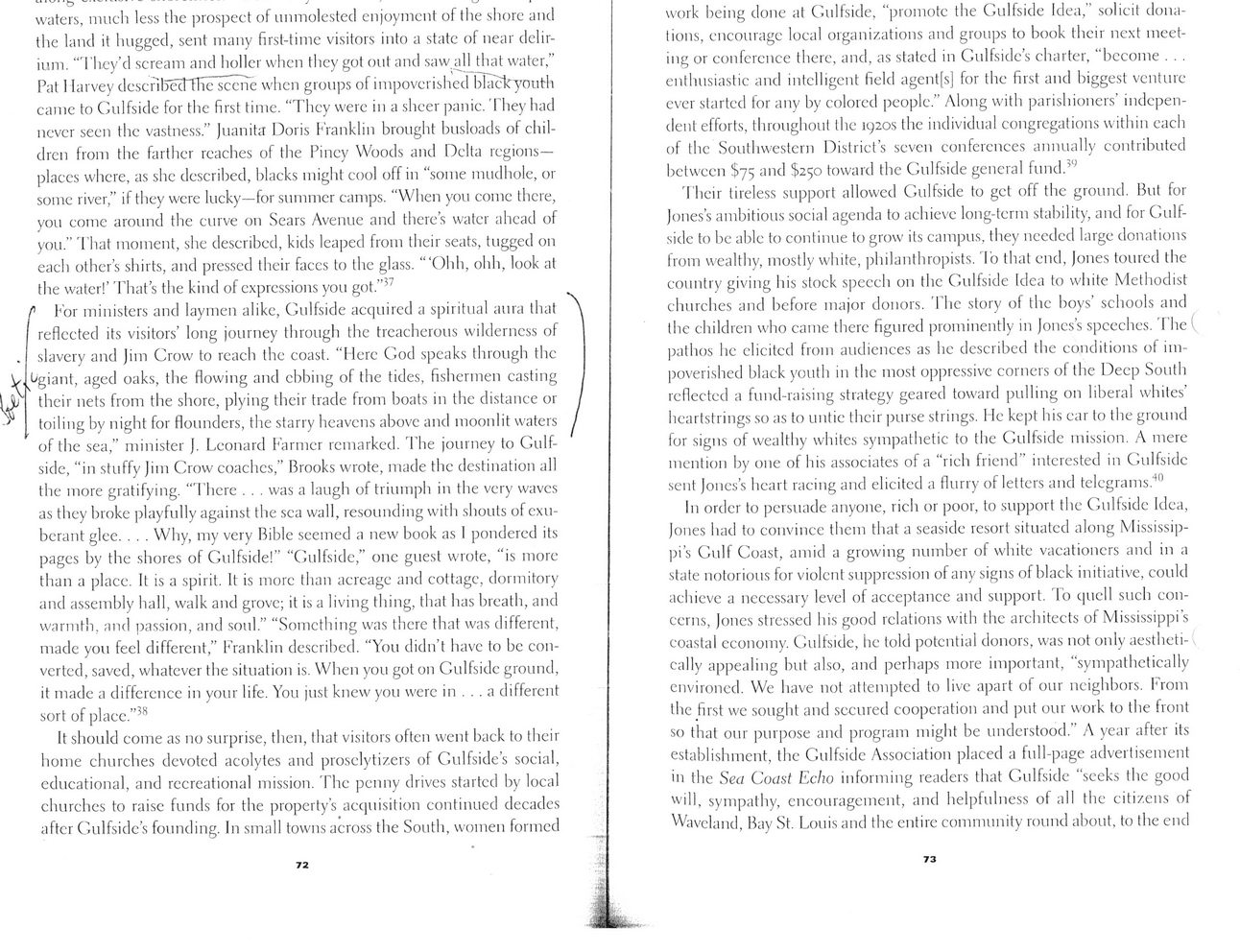This text was obtained via automated optical character recognition.
It has not been edited and may therefore contain several errors.
waters, much less the prospect of unmolested enjoyment of the shore and the land it hugged, sent many first-time visitors into a state of near delirium. “They’d scream and holler when they got out and saw all that water,” Pat 1 Iarvey descnbecTFhc scene when groups of impoverished blaelcyouth came to Gulfside for the first time. “They were in a sheer panic. They had never seen the vastness.” Juanita Doris Franklin brought busloads of children from the farther reaches of the Pincy Woods and Delta regions— placcs where, as she described, blacks might cool off in “some mudhole, or some river,” if they were lucky—for summer camps. “When you come there, you come around the curve on Sears Avenue and there’s water ahead of you.” That moment, she described, kids leaped from their seats, tugged on each other’s shirts, and pressed their faces to the glass. ‘“Ohh, ohli, look at the water!’ That’s the kind of expressions you got.”37 P For ministers and laymen alike, Gulfside acquired a spiritual aura that reflected its visitors’ long journey through the treacherous wilderness of slavery and Jim Grow to reach the coast. “Here God speaks through the kgiant, aged oaks, the flowing and ebbing of the tides, fishermen casting their nets from the shore, plying their trade from boats in the distance or toiling by night for flounders, the starry heavens above and moonlit waters of the sea,” minister J. Leonard Farmer remarked. The journey to Gulfside, “in stuffy Jim Crow coaches,” Brooks wrote, made the destination all the more gratifying. “There . . . was a laugh of triumph in the very waves as they broke playfully against the sea wall, resounding with shouts of exuberant glee. . . . Why, my very Bible seemed a new book as 1 pondered its pages by the shores of Gulfside!” “Gulfside,” one guest wrote, “is more than a placc. It is a spirit. It is more than acreage and cottage, dormitory and assembly hall, walk and grove; it is a living thing, that has breath, and warmth, and passion, and soul.” “Something was there that was different, made you feel different,” Franklin described. “You didn’t have to be converted, saved, whatever the situation is. When you got on Gulfside ground, it made a difference in your life. You just knew you were in ... a different sort of place.”38 It should come as no surprise, then, that visitors often went back to their home churches devoted acolytes and prosclytizers of Gulfside’s social, educational, and recreational mission. The penny drives started by local churches to raise funds for the property’s acquisition continued decades after Gulfside’s founding. In small towns across the South, women formed work being done at Gulfside, “promote the Gulfside Idea,” solicit donations, encourage local organizations and groups to book their next meeting or confcrcnce there, and, as stated in Gulfside’s charter, “become . . . enthusiastic and intelligent field agentfs] for the first and biggest venture ever started for any by colored people.” Along with parishioners’ independent efforts, throughout the 1920s the individual congregations within each of the Southwestern District’s seven conferences annually contributed between $75 and $250 toward the Gulfside general fund.39 Their tireless support allowed Gulfside to get off the ground. But for Jones’s ambitious social agenda to achieve long-term stability, and for Gulfside to be able to continue to grow its campus, they needed large donations lrom wealthy, mostly white, philanthropists, lb that end, Jones toured the country giving his stock speech on the Gulfside Idea to white Methodist churches and before major donors. The story of the boys’ schools and the children who came there figured prominently in Jones’s speeches. Hie ( pathos lie elicited from audiences as he described the conditions of impoverished black youth in the most oppressive corners of the Deep South reflected a fund-raising strategy geared toward pulling on liberal whites’ heartstrings so as to untie their purse strings. He kept his ear to the ground for signs of wealthy whites sympathetic to the Gulfside mission. A mere mention by one of his associates of a “rich friend” interested in Gulfside sent Jones’s heart racing and elicited a flurry of letters and telegrams40 In order to persuade anyone, rich or poor, to support the Gulfside Idea, Jones had to convince them that a seaside resort situated along Mississippi’s Gulf Coast, amid a growing number of white vacationers and in a state notorious for violent suppression of any signs of black initiative, could achieve a necessary level of acceptance and support. To quell such concerns, Jones stressed his good relations with the architects of Mississippi’s coastal economy. Gulfside, he told potential donors, was not only aesthetically appealing but also, and perhaps more important, “sympathetically environed. We have not attempted to live apart of our neighbors. From the first we sought and secured cooperation and put our work to the front so that our purpose and program might be understood.” A year after its establishment, the Gulfside Association placed a full-page advertisement in the Sea Coast Echo informing readers that Gulfside “seeks the good will, sympathy, encouragement, and helpfulness of all the citizens of Waveland, Bay St. Louis and the entire community round about, to the end

Gulfside Methodist Assembly Land-was-Ours---book-Kahrl-(08)